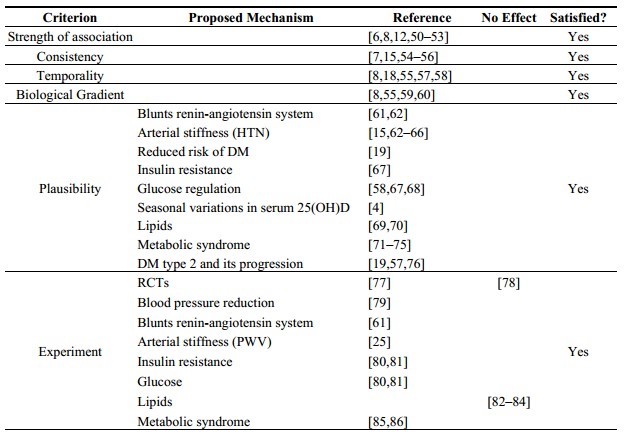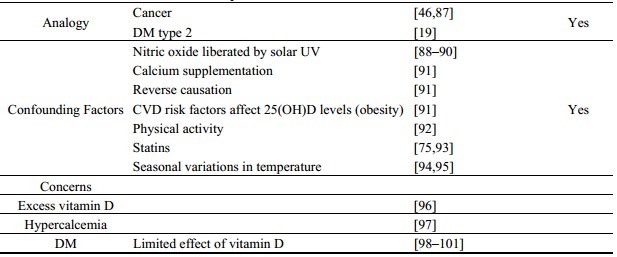Cardiovascular Disease is associated with lack of Vitamin D - meets most of Hill's Criteria
Does Sufficient Evidence Exist to Support a Causal Association between Vitamin D Status and Cardiovascular Disease Risk? An Assessment Using Hill’s Criteria for Causality
nutrients, ISSN 2072-6643
Patricia G. Weyland William B. Grant and Jill Howie-Esquivel
Department of Physiological Nursing, School of Nursing, University of California, San Francisco (UCSF), #2 Koret Way Box 0610, San Francisco, CA 94143, USA; E-Mail: [email protected]
Sunlight, Nutrition, and Health Research Center, P.O. Box 641603, San Francisco, CA 94164-1603, USA; E-Mail: [email protected]
- Author to whom correspondence should be addressed; E-Mail: [email protected]; Tel.: +1-831-420-7324.
Received: 22 May 2014; in revised form: 31 July 2014 /Accepted: 18 August 2014 / Published: 2 September 2014
Serum 25-hydroxyvitamin D (25(OH)D) levels have been found to be inversely associated with both prevalent and incident cardiovascular disease (CVD) risk factors; dyslipidemia, hypertension and diabetes mellitus.
This review looks for evidence of a causal association between low 25(OH)D levels and increased CVD risk.
We evaluated journal articles in light of Hill’s criteria for causality in a biological system.
The results of our assessment are as follows.
Strength of association: many randomized controlled trials (RCTs), prospective and cross-sectional studies found statistically significant inverse associations between 25(OH)D levels and CVD risk factors.
Consistency of observed association: most studies found statistically significant inverse associations between 25(OH)D levels and CVD risk factors in various populations, locations and circumstances.
Temporality of association: many RCTs and prospective studies found statistically significant inverse associations between 25(OH)D levels and CVD risk factors.
Biological gradient (dose-response curve): most studies assessing 25(OH)D levels and CVD risk found an inverse association exhibiting a linear biological gradient.
Plausibility of biology: several plausible cellular-level causative mechanisms and biological pathways may lead from a low 25(OH)D level to increased risk for CVD with mediators, such as dyslipidemia, hypertension and diabetes mellitus.
Experimental evidence: some well-designed RCTs found increased CVD risk factors with decreasing 25(OH)D levels.
Analogy: the association between serum 25(OH)D levels and CVD risk is analogous to that between 25(OH)D levels and the risk of overall cancer, periodontal disease, multiple sclerosis and breast cancer.
Conclusion: all relevant Hill criteria for a causal association in a biological system are satisfied to indicate a low 25(OH)D level as a CVD risk factor.
Tables in the PDF



Vitamin D Life merged two of the tables.
| Criteria | Proposed Vitamin D Mechanism | Satisfied? | |
| Strength of association | Is there a large difference in the outcome between exposed and non-exposed persons? | Yes | |
| Consistency | Has the outcome been observed by multiple researchers, in various circumstances, places and at different times? | Yes | |
| Temporality | Does the cause always precede the effect? | Yes | |
| Biological Gradient | Is there a dose-response curve? | Yes |
| | Blunts renin-angiotensin system |
| | Arterial stiffness (HTN) |
| | Reduced risk of DM |
| | Insulin resistance | || Plausibility | Is the suspected causation consistent with
current knowledge of biology? | Glucose regulation | Yes
| | Seasonal variations in serum 25(OH)D |
| | Lipids |
| | Metabolic syndrome |
| | DM type 2 and its progression |
| | RCTs |
| | Blood pressure reduction |
| | Blunts renin-angiotensin system | || Experiment | Has an observed association led to a
preventive action that has prevented the outcome? | Arterial stiffness (PWV) Insulin resistance | Yes
| | Lipids | Metabolic syndrome | || Analogy | Is there an analogous exposure and outcome? | Cancer DM type 2 | Yes
| | Nitric oxide liberated by solar UV |
| | Calcium supplementation |
| | Reverse causation | |
See also Vitamin D Life
- Criteria to associate a health problem with low vitamin D
- if more than 7 of 22 features are evident then Vitamin D Life suspect the health probulem is associated with vitamin D
- Overview Cardiovascular and vitamin D
- There are many indications that vitamin D can both PREVENT and TREAT many cardiovascular problems
Cardiovascular category listing with associated searches
All items in category Metabolic Syndrome and Vitamin D items
The TOP articles in Cardiovascular and Vitamin D are listed here:
{category}
Pages listed in BOTH the categories Cardiovascular and Meta-analysis
{category}
Pages listed in BOTH the categories Intervention and Cardiovascular
{category}
